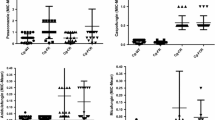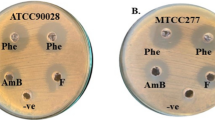Abstract
The synergistic anticandidal activity of three diketopiperazines [cyclo-(l-Pro-l-Leu) (1), cyclo-(d-Pro-l-Leu) (2), and cyclo-(d-Pro-l-Tyr) (3)] purified from a Bacillus sp. N strain associated with entomopathogenic nematode Rhabditis (Oscheius) in combination with amphotericin B and clotrimazole was investigated using the macrodilution method. The minimum inhibitory concentration and minimum fungicidal concentration of the diketopiperazines was compared with that of the standard antibiotics. The synergistic anticandidal activities of diketopiperazines with amphotericin B or clotrimazole were assessed using the checkerboard and time-kill methods. The results of the present study showed that the combined effects of diketopiperazines with amphotericin B or clotrimazole predominantly recorded synergistic (<0.5). Time-kill study showed that the growth of the Candida was completely attenuated after 12–24 h of treatment with 50:50 ratios of diketopiperazines and antibiotics. These results suggest that diketopiperazines combined with antibiotics may be microbiologically beneficial and not antagonistic. These findings have potential implications in delaying the development of resistance as the anticandidal effect is achieved with lower concentrations of both drugs (diketopiperazines and antibiotics). The cytotoxicity of diketopiperazines was also tested against two normal human cell lines (L231 lung epithelial and FS normal fibroblast) and no cytotoxicity was recorded for diketopiperazines up to 200 μg/mL. The in vitro synergistic activity of diketopiperazines with antibiotics against Candida albicans is reported here for the first time.

Similar content being viewed by others
References
Adams ML, Kwon GS (2003) Relative aggregation state and hemolytic activity of amphotericin B encapsulated bypoly(ethylene oxide)-block-poly(N-hexyI-l-aspartamide)-acylconjugate micelles: effects of acyl chain length. J Control Release 87:23–32
Anto RJ, Venkataraman M, Karunagaran D (2003) Inhibition of NF-KB sensitizes A431 cells to epidermal growth factor-induced apoptosis, whereas its activation by ectopic expression of RelA confers resistance. J Biol Chem 28:25490–25498
Banerjee SN, Emori TG, Culver DH, Gaynes RP, Jarvis WR, Horan T (1991) Secular trends in nosocomial primary bloodstream infections in the United States, National Nosocomial Infections Surveillance System. Am J Med 91:86–89
Barchiesi F, Maracci M, Radi B, Arzeni D, Bladassarri I, Giacometti A, Scalise G (2002) Point prevalence, microbiology and fluconazole susceptibility patterns of yeast isolates colonizing the oral cavities of HIV-infected patients in the era of highly active antiretroviral therapy. J Antimicrob Chemother 50:999–1002
Beck-Sague C, Banerjee S, Jarvis WR (1993) Infectious diseases and mortality among US nursing home residents. Am J Public Health 83:1739–1742
Beringer PM (1999) New approaches to optimizing antimicrobial therapy in patients with cystic fibrosis. Cur Opinon Pul Med 5:371–377
Borisy AA, Elliott PJ, Hurst NW, Lee MS, Lehar J, Price ER, Serbedzija G, Zimmermann GR, Foley MA, Stockf BR, Keithet C (2003) Systematic discovery of multicomponent therapeutics. Proc Natl Acad Sci 100:7977–7982
Cain CC, Dongho L, Robert H, Waldo II, Alexis T, Henry EJ, Casida J, Mansukh C, Wan ME, Wall MC, Oberlies NH, Joseph OF (2003) Synergistic antimicrobial activity of metabolites produced by a non obligate bacterial predator. Antimicrob Agents Chemother 47(7):2113–2117
Cowen LE, Lindquist S (2005) Hsp90 potentiates the rapid evolution of new traits: drug resistance in diverse fungi. Science 309:2185–2189
Degrassi G, Aguilar C, Bosco M, Zahariev S, Pongor S, Ventur V (2002) Plant growth-promoting Pseudomonas putida WCS358 produces and secretes four cyclic dipeptides: cross-talk with quorum sensing bacterial sensors. Curr Microbiol 45:250–254
Demain AL, Zhang L (2005) In: Zhang L, Demain AL (eds) Natural products: drug discovery and therapeutics medicines. Humana, Totowa, pp 3–32
Eckmanns T, Ruden H, Gastmeier P (2006) The influence of high-efficiency particulate air filtration on mortality and fungal infection among highly immunosuppressed patients: a systematic review. J Infect Dis 193:1408–1418
Edmond MB, Wallace SE, McClish DK, Pfaller MA, Jones RN, Wenzel RP (1999) Nosocomial bloodstream infections in United States hospitals: a three-year analysis. Clin Infect Dis 29:239–244
Forst S, Nealson KH (1996) Molecular Biology of the symbiotic-pathogenic bacteria Xenorhabdus spp. and Photorhabdus spp. Microbiol 51:47–72
George M, Eliopoulos GM, Robert C, Moellering JR (1996) Antimicrobial combinations. Antibiotics in laboratory medicine. Williams and Wilkins, Baltimore, pp 330–396
Ghannoum MA, Rice LB (1999) Antifungal agents: mode of action, mechanisms of resistance, and correlation of these mechanisms with bacterial resistance. Clin Microbiol Rev 12:501–517
Goodman JL, Winston DJ, Greenfield RA, Chandrasekar PH, Fox B, Kaizer H, Shadduck RK, Shea TC, Stiff P, Friedman DJ, Powderly WG, Silber JL, Horowitz H, Lichtin A, Wolff SN, Mangan KF, Silver SM, Weisdorf D, Ho WG, Gilbert G, Donald B (1992) A controlled trial of fluconazole to prevent fungal infections in patients undergoing bone marrow transplantation. N Engl J Med 326:845–851
Graybill JR, Revankar SG, Patterson TF (1998) In: Ajello L, Hay RJ (eds) Topley and Wilson’s microbiology and microbial infections, vol 4, 9th edn. Arnold, London, pp 163–165
Heitman J (2005) A fungal achilles' heel. Science 309:2175–2176
Hindler JA (2000) Special antimicrobial susceptibility tests. In: Mahon CR, Manusalis G (eds) Text book of the diagnostic microbiology, 2nd edn. WB Saunders, Philadelphia, pp 97–104
Hossain MA, Reyes GHL, Long A, Mukherjee PK, Ghannoum MA (2003) Efficacy of caspofungin combined with amphotericin B against azole-resistant Candida albicans. J Antimicrob Chemother 51:1427–1429
Johnson MD, MacDougall C, Ostrosky-Zeichner L, Perfect JR, Rex JH (2004) Combination antifungal therapy. Antimicrob Agents Chemother 48:693–715
Klepser ME, Ernst EJ, Lewis RE, Ernst ME, Pfaller MA (1998) Influence of test conditions on antifungal time-kill curve results: proposal for standardized methods. Antimicrob Agents Chemother 47:1207–1212
Kumar NS, Mohandas C, Siji JV, Rajasekharan KN, Nambisan B (2012) Identification of antimicrobial compound, diketopiperazines, from a Bacillus sp. N strain associated with a rhabditid entomopathogenic nematode against major plant-pathogenic fungi. J Appl Microbiol 113:914–924
Larocco MT, Burgert SJ (1997) Infection in the bone marrow transplant recipient and the role of the clinical microbiology laboratory in clinical transplantation. Clin Microbiol Rev 10:277–297
Lebouvier N, Pagniez F, Duflos M, Le Pape P, Na YM, Bauta LM (2007) Synthesis and antifungal activities of new fluconazole analogues with azaheterocycle moiety. Bioorg Medi Chem Lett 17:3686–3689
Lewis RE, Kontoyiannis DP (2001) Rationale for combination antifungal therapy. Pharmacother 21:149–164
Marokhazi J, Lengyel K, Pekar S, Felfoldi G, Patthy A, Graf L, Fodar A, Venekei I (2004) Comparison of proteolytic activities produced by entomopathogenic Photorhabdus bacteria: Strain- and phase-dependent heterogeneity in composition and activity of four enzymes. Appl Environ Microbiol 70:7311–7320
Martins MB, Carvalho I (2007) Diketopiperazines: biological activity and synthesis. Tetrahedron 63:9923–9932
Mccleland K, Milne PJ, Lucieto FR, Frost C, Brauns SC, Van De Venter M, Du Plessis J, Dyason K (2004) An investigation into the biological activity of the selected histidine-containing diketopiperazines cyclo(His-Phe) and cyclo(His-Tyr). J Pharmacy Pharmacol 56:1143–1153
Morrell M, Fraser VJ, Kollef MH (2005) Delaying the empiric treatment of Candida bloodstream infection until positive blood culture results are obtained: a potential risk factor for hospital mortality. Antimicrob Agents Chemother 49:3640–3645
Pereira-Cencil T, Del Bel Cury AA, Crielaard W, Ten Cate JM (2008) Development of Candida-associated denture stomatitis: new insights. J Applied Oral Sci 16(2):86–94
Pillai SK, Moellering RC (2005) Antimicrobial combinations. Antibiotics in laboratory medicine. Lippincott Williams and Wilkins, New York, pp 365–400
Prasad C (1995) Bioactive cyclic dipeptides. Peptides 16:151–164
Rangel-Frausto MS, Wilblin T, Blumberg HM, Saiman L, Patterson J, Rinaldi M, Michael R, Michael P, John EE, William J, Jeffrey D, Wenzelet RP (1999) National epidemiology of mycoses survey (NEMIS): variations in rates of bloodstream infections due to Candida species in seven surgical intensive care units and six neonatal intensive care units. Clin Infect Dis 29:253–258
Rex JH, Pappas PG, Karchmer AW, Sobel J, Edwards J, Hadley S, Brass C, Vazquez JA, Chapman S, Horowitz H, Zervos M, McKinsey D, Lee J, Babinchak T, Bradsher RW, Cleary JD, Cohen DM, Danziger L, Goldman M, Goodman J, Hilton E, Hyslop NE, Kett DH, Lutz J, Rubin RH, Scheld WM, Schuster M, Simmons B, Stein DK, Washburn RG, Mautner L, Chu T, Panzer H, Rosenstein R, Booth J (2003) A randomized and blinded multicenter trial of high-dose fluconazole plus placebo versus fluconazole plus amphotericin B as therapy for candidemia and its consequences in non neutropenic subjects. Clin Infect Dis 36:1221–1228
Rex JH, Rinaldi MG, Pfaller MA (1995) Resistance of Candida species to fluconazole. Antimicrob Agents Chemother 39:1–8
Rhee KH (2002) Isolation and characterization of Streptomyces sp. KH-614 producing anti-VRE (vancomycin-resistant enterococci) antibiotics. J Gen Appl Microbiol 48:327–331
Rhee KH (2003) Purification and identification of an antifungal agent from Streptomyces sp. KH-614 antagonistic to rice blast fungus, Pyricularia oryzae. J Microbiol Biotechnol 13(6):984–988
Rhee KH (2004) Cyclic dipeptides exhibit synergistic, broad spectrum antimicrobial effects and have anti-mutagenic properties. Int J antimicrobial agents 24:423–427
Rosa SD, Mitova M, Tommonaro G (2003) Marine bacteria associated with sponge as source of cyclic peptides. Biomol Eng 20:311–316
Sanchez V, Vasquez JA, Barth-Jones D, Dembry L, Sobel JD, Zervus MJ (1993) Nosocomial acquisition of Candida parapsilosis: an epidemiologic study. Am J Med 94:577–582
Strom K, Sjogren J, Broberg A, Schnurer J (2002) Lactobacillus plantarum MiLAB 393 produces the antifungal cyclic dipeptides cyclo(l-Phe-l-Pro) and cyclo(l-Phe-trans-4-OH-l-pro) and 3-phenyllactic acid. Appl Environ Microbiol 68:4322–4327
Sugar AM, Alsip SG, Galgiani JN, Graybill JR, Dismukes WE, Cloud GA, Craven PC, Stevens DA (1997) Pharmacology and toxicity of high-dose ketoconazole. Antimicrob Agents Chemother 31:1874–1878
Yan PS, Song Y, Sakuno E, Nakajima H, Nakagawa H, Yabe K (2004) Cyclo(l-Leucyl-l-Prolyl) produced by Achromobacter xylosoxidans inhibits aflatoxin production by Aspergillus parasiticus. Appl Environ Microbiol 70:7466–7473
Acknowledgments
The authors are grateful to Indian Council Medical Research (ICMR) and the Government of India for funding. We thank the Director, CTCRI, for providing facilities for the work.
Conflict of Interest
The authors declare that they have no conflict of interest.
Author information
Authors and Affiliations
Corresponding author
Rights and permissions
About this article
Cite this article
Kumar, S.N., Nambisan, B., Mohandas, C. et al. In vitro synergistic activity of diketopiperazines alone and in combination with amphotericin B or clotrimazole against Candida albicans . Folia Microbiol 58, 475–482 (2013). https://doi.org/10.1007/s12223-013-0234-x
Received:
Accepted:
Published:
Issue Date:
DOI: https://doi.org/10.1007/s12223-013-0234-x




